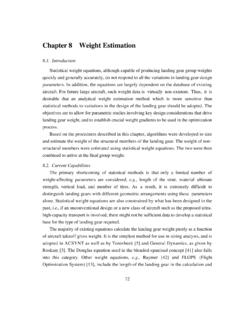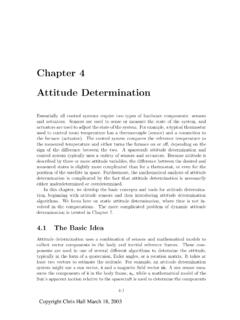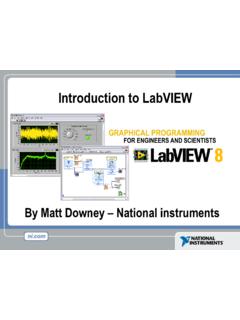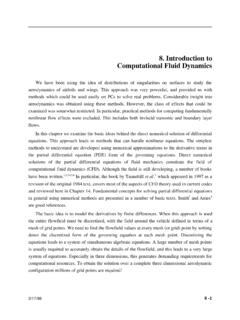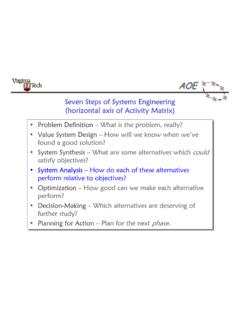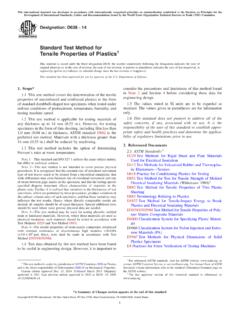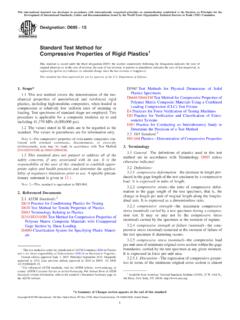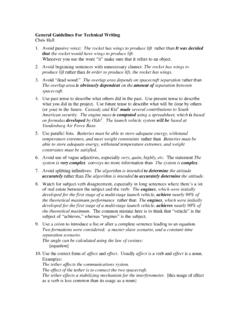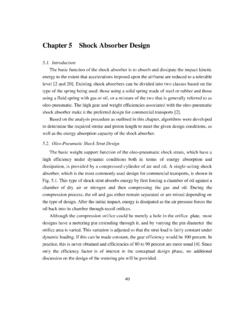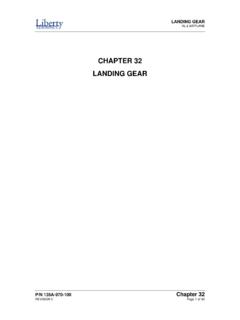Transcription of Chapter 3 Landing Gear Concept Selection - Virginia Tech
1 14 Chapter 3 Landing gear Concept Selection Introduction The design and positioning of the Landing gear are determined by the unique characteristics associated with each aircraft, , geometry, weight, and mission requirements. Given the weight and cg range of the aircraft, suitable configurations are identified and reviewed to determine how well they match the airframe structure, flotation, and operational requirements. The essential features, , the number and size of tires and wheels, brakes, and shock absorption mechanism, must be selected in accordance with industry and federal standards discussed in the following chapters before an aircraft design progresses past the Concept formulation phase, after which it is often very difficult and expensive to change the design [19].
2 Three examples of significant changes made after the initial design include the DC-10-30, which added the third main gear to the fuselage, the Airbus A340, where the main gear center bogie increased from two to four wheels in the -400 series, and the Airbus A-300, where the wheels were spread further apart on the bogie to meet LaGuardia Airport flotation limits for US operators. Based on the design considerations as discussed in this Chapter , algorithms were developed to establish constraint boundaries for use in positioning the Landing gear , as well as to determine whether the design characteristics violate the specified requirements. The considerations include stability at takeoff/touchdown and during taxiing, braking and steering qualities, gear length, attachment scheme, and ground maneuvers.
3 Configuration Selection The nose wheel tricycle undercarriage has long been the preferred configuration for passenger transports. It leads to a nearly level fuselage and consequently the cabin floor when the aircraft is on the ground. The most attractive feature of this type of undercarriages is the improved stability during braking and ground maneuvers. Under normal Landing attitude, the relative location of the main assembly to the aircraft cg produces a nose-down pitching moment upon touchdown. This moment helps to reduce the angle of attack of the aircraft and thus the lift generated by the wing. In addition, the braking forces, which act behind the aircraft cg, have a stabilizing effect and thus enable the pilot to make full use of the brakes.
4 These factors all contribute to a shorter Landing field length requirement. 15 The primary drawback of the nose wheel tricycle configuration is the restriction placed upon the location where the main Landing gear can be attached. With the steady increase in the aircraft takeoff weight, the number of main assembly struts has grown from two to four to accommodate the number of tires required to distribute the weight over a greater area. However, stability and performance constraints as identified by Holloway et al. [10] and Sliwa [11] effectively eliminate all but a few locations where the main assembly can be attached. The attachment limitation phenomenon is known as the location stagnation [App.]
5 A] and can become a major concern for future large aircraft, where additional tires and struts are required to alleviate the load being applied to the pavement. Typically, a large trailing-edge extension, , the Yehudi,1 is employed to alleviate at least in part the location stagnation problem. The Yehudi can result in weight and aerodynamic penalties due to local structural reinforcement and increased wetted area, respectively. However, the increased root chord also allows an increase in absolute root thickness for a given t/c. This advantage may outweigh other penalties. Landing gear Disposition The positioning of the Landing gear is based primarily on stability considerations during taxiing, liftoff and touchdown, , the aircraft should be in no danger of turning over on its side once it is on the ground.
6 Compliance with this requirement can be determined by examining the takeoff/ Landing performance characteristics and the relationships between the locations of the Landing gear and the aircraft cg. Angles of Pitch and Roll During Takeoff and Landing The available pitch angle ( ) at liftoff and touchdown must be equal, or preferably exceed, the requirements imposed by performance or flight characteristics. A geometric limitation to the pitch angle is detrimental to the liftoff speed and hence to the takeoff field length. Similarly, a geometric limitation to the roll angle ( ) could result in undesirable operational limit under cross-wind Landing condition. 1 Apparently known as a Yehudi , this inboard trailing edge extension actually first appeared on the Boeing B-29 to solve a fuselage-nacelle interference problem.
7 Douglas used it first on a swept wing transport on the DC-8, and it was not adopted by Boeing until the 707 design went to the -320 model. The name was first used to describe the wind tunnel part that was made on the spot during the wind tunnel test. Who s Yehudi was a running gag on a popular radio show at the time, as well as the name of a popular violinist (letter from Bill Cook, retired Boeing engineer and author of The Road to the 707). 16 For a given aircraft geometry and gear height (hg), the limit for the takeoff/ Landing pitch angle follows directly from Fig. The roll angle at which the tip of the wing just touches the ground is calculated using the expression [5, p. 350] tantantantan!"=+##$%2hstg ( ) In this case, is taken as the dihedral angle, s is the wing span, t is the wheel track, and is the wing sweep.
8 Similar conditions may be deduced for other parts of the aircraft, except that , and s in Eq. ( ) must be replaced with appropriate values. For example, the permissible roll angle associated with nacelle-to-ground clearance is determined with the following values: measured from the horizon to the bottom of the nacelle in the front view, measured from the chosen Landing gear location to the engine in the top view, and s the distance between the engines. Pitch Angle Required for Liftoff The takeoff rotation angle is prescribed in preliminary design, and then estimated. The final values for and are found as the detailed performance characteristics of the aircraft become available. The pitch angle at liftoff ( LOF) is calculated using the expression [5, p.]
9 350] !"!"LOFLOFLOFLL ddtlVlCgdCdLOF=++#$%%&'((212/ ( ) where LOF is the highest angle of attack anticipated for normal operational use, VLOF is the liftoff speed, g is the gravitational acceleration CL, LOF is the lift coefficient, and dCL/d is the lift-curve slope. As shown in Fig. , the dimension of l1 and l2 are defined by the line connecting the tire-ground contact point upon touchdown and the location of the tail bumper, if one is present. For large transports, the typical value for the rate of rotation (d /dt) is taken as four degrees per second [5]. 17 tshgtip loss!"static groundline a) Front view Chosen gear location! b) Top view !l2l1esstatic groundline c) Side view Figure Geometric definitions in relation to the pitch and roll angles [5] 18 The detailed aerodynamic data required to use Eq.
10 ( ) is not always available at the conceptual design stage. In most aircraft the aft-body and/or tail bumper is designed such that the aircraft cannot rotate by more than a specified number of degrees at liftoff. Typically, the value is between 12 and 15 degrees [2]. In addition to the tail scrape problem, the aircraft cg cannot rotate over and aft of the location of the main assembly, a phenomenon known as tail tipping and is critical during Landing . Pitch and Roll Angles During Landing With the flaps in the fully-deflected position, the critical angle of attack of the wing during Landing is smaller than in takeoff. Consequently, the pitch angle during Landing is generally less than that during takeoff. In the absence of detailed information, the pitch angle on touchdown ( TD) may be assumed equal to LOF.
